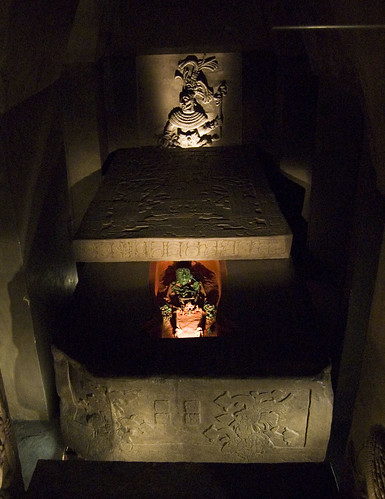The Tomb of Pakal in the National Museum of Anthropology in Mexico City.
---- ----
K'inich Janaab' Pakal (23 March 603 - 28 August 683) was ruler of the Maya polity of Palenque in the Late Classic period of pre-ColumbianMesoamerican chronology. During a long reign of some 68 years Pakal was responsible for the construction or extension of some of Palenque's most notable surviving inscriptions and monumental architecture.
Before his name was securely deciphered from extant Maya inscriptions, this ruler has been known by an assortment of nicknames and approximations, common ones including Pakal (or Pacal), "Sun Shield", "8 Ahau", and (familiarly) as "Pacal the Great".
In modern sources his name is also sometimes appended with a regnal number, to distinguish him from other Janaab' Pakals that either preceded or followed him in the dynastic lineage of Palenque. Confusingly, he has at times been referred to as either "Pakal I" or "Pakal II". The reference to him as Pakal II takes into account that his maternal grandfather (who died in 612) was also named Janaab' Pakal. However, although his grandfather was a personage of ajaw ranking most recent inscriptional interpretations hold that he probably did not himself hold the actual rulership position over the Palenque city-state. When instead the name Pakal I is used, this serves to distinguish him from two later known successors to the Palenque rulership, Upakal K'inich Janaab' Pakal (ruled c. 742, aka "[K'inich Janaab'] Pakal II") and Wak Kimi Janaab' Pakal (aka [Janaab'] Pakal III), the last-known Palenque ruler who acceded in 799.
Pakal ascended the throne at age 12 on July 29, 615, and lived to the age of 80. The name pakal means "shield" in the Maya language.
Pakal saw expansion of Palenque's power in the western part of the Maya states, and initiated a building program at his capital that produced some of Maya civilization's finest art and architecture.
He was preceded as ruler of Palenque by his mother Lady Sak K'uk'. As the Palenque dynasty seems to have had Queens only when there was no eligible male heir, Sak K'uk' transferred rulership to her son upon his official maturity.
After his death Pakal was succeeded by his son Chan Bahlum II. A younger son, Kan Xul II, succeeded his brother Chan Bahlum II.
After his death, Pakal was deified and said to communicate with his descendants. Pakal was buried within the Temple of Inscriptions. Though Palenque had been examined by archaeologists before, the secret to opening his tomb—closed off by a stone slab with stone plugs in the holes, which had until then escaped the attention of archaeologists—was discovered by Mexican archaeologist Alberto Ruz Lhuillier in 1948. It took four years to clear the rubble from the stairway leading down to Pakal’s tomb, but was finally uncovered in 1952 His skeletal remains were still lying in his coffin, wearing a jade mask and bead necklaces, surrounded by sculptures and stucco reliefs depicting the ruler's transition to divinity and figures from Maya mythology.
That the bones within the tomb are really those of Pakal himself is under debate due to the fact that the analysis of wear on the skeleton’s teeth places the age of the owner at death as 40 years younger than Pakal would’ve been at his death. Epigraphers insist that the inscriptions on the tomb indicate that it is indeed K'inich Janaab' Pakal entombed within, and that he died at the age of 80 after ruling for around 70 years. Some contest that the glyphs refer to two people with the same name or that an unusual method for recording time was used, but other experts in the field say that allowing for such possibilities would go against everything else that is known about the Maya calendar and records of events. The most commonly accepted explanation for the irregularity is that Pakal, being an elite, had access to softer, less abrasive food than the average person so that his teeth naturally acquired less wear [2]. Despite the controversy, it remains one of the most spectacular finds of Maya archeology. A replica of his tomb is found at the National Museum of Anthropology and History in Mexico City.
http://en.wikipedia.org/wiki/Pakal














No hay comentarios:
Publicar un comentario